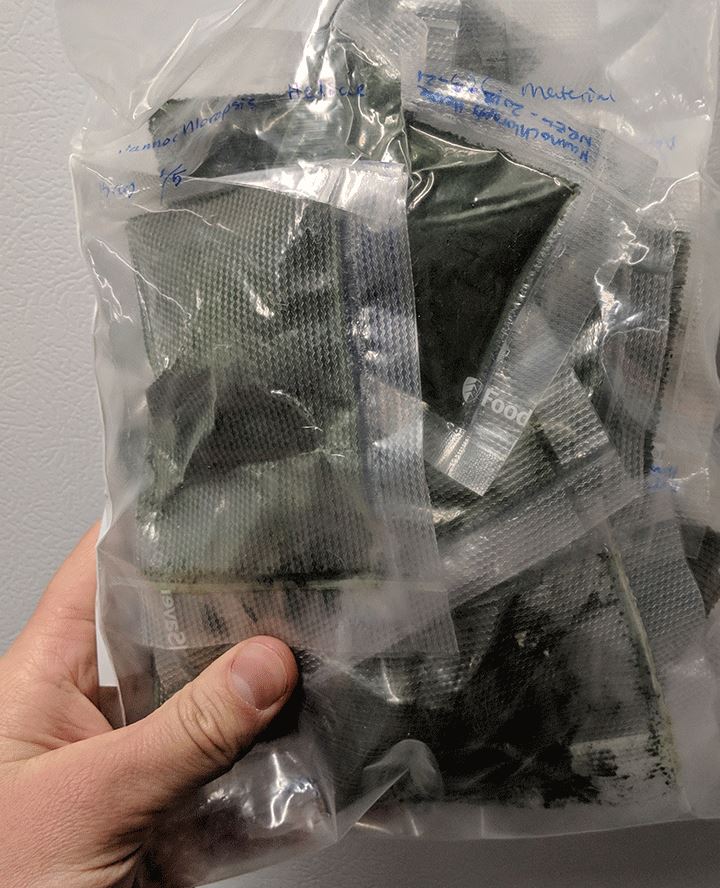Algae Compositional Analysis Laboratory Procedures
NLR has developed laboratory analytical procedures (LAPs) for algae to help scientists and analysts understand more about the chemical composition of algae as a feedstock for a multitude of applications.
The compositional analysis tools described and highlighted here are focused on algal biomass, which is defined as a feedstock that can originate from either microalgae or macroalgae (including seaweed).

Example of freeze-dried and vacuum sealed packages of algae biomass. Photo by NLR
Sample Reference Biomass Material
A sample of algal biomass (derived from microalgae from various species, and macroalgae or seaweed) material, freeze dried and vacuum packed, with reported compositional profile can be made available upon request for collaborating groups aiming to align data between different procedures or fine-tuning the implementation of the microalgae compositional analysis methods.
Capabilities
NLR's algal research team can work with you to deliver technology solutions to complex R&D questions. The team is also able to analyze the chemical composition of specific algae and seaweed samples and develop a custom analysis plan based on individual needs.
Procedures
NLR wrote these analytical procedures to help the research community analyze algae.
This procedure describes a method to quantitatively extract phytopigments from microalgae biomass as well as to identify and quantify individual pigments based on separation and detection with a high-performance liquid chromatography system coupled to a diode array detector. This procedure addresses the issue of extraction efficiency by establishing a measurement of extraction yield based on determination of phytol from chlorophyll in the initial biomass and the residual biomass after extraction.
Download the procedure for Identification and Quantification of Photosynthetic Pigments in Algae (2022).
This procedure guides the integration of LAPs to measure algal biomass constituents in an unambiguous manner and ultimately achieve mass balance closure for algal biomass samples. Many of these methods build on years of research in algal biomass analysis.
By combining the appropriate LAPs, the goal is to break the biomass sample into constituents that sum to as close to 100% by weight as possible. Some of these constituents are individual components, such as carbohydrates and lipids as total fatty acids, and some can be groups of compounds, such as extractable lipids. Quantification of protein content in algae is currently described as a calculation from measurement of elemental nitrogen content using a nitrogen-to-protein conversion factor that is specific for micro- or macroalgae.
Download the procedure for Summative Mass Analysis of Algal Biomass (2023).
This procedure uses two-step sulfuric acid hydrolysis to hydrolyze the polymeric forms of carbohydrates in algal biomass into monomeric subunits. The monomers are then quantified by either high-performance liquid chromatography (HPLC), high-performance anion exchange chromatography (HPAEC), or a suitable spectrophotometric method.
An optimized hydrolysis procedure is expected to yield complete hydrolysis of all polymeric structural and storage carbohydrates into monomers. A range of sequential and optimized inorganic acid hydrolysis conditions with respective hydrolysis liquor collection and analysis should be carried out for algal biomass.
Download the procedure for Determination of Total Carbohydrates in Algal Biomass (2023).
This procedure is based on a whole biomass transesterification of lipids to fatty acid methyl esters (FAME) to represent an accurate reflection of the potential of microalgal biofuels. Lipids are present in many forms and play various roles within an algal cell, from cell membrane phospholipids to energy stored as triacylglycerols. The ability to identify and accurately quantify the fatty acid content of these lipids, as well as free fatty acids, is essential to evaluating fuel potential and establishing a comprehensive compositional analysis of algae.
Download the procedure for Determination of Total Lipids as Fatty Acid Methyl Esters (2023).
This procedure describes two methods to determine the amount of moisture or total solids present in a freeze-dried algal biomass sample via convection drying, as well as the ash content via dry oxidation at 575°C, respectively.
Algal biomass samples may contain a high and varying percentage of moisture, which can change rapidly when exposed to ambient humidity levels. These samples also may contain varying percentages of ash depending on species and the presence of growth media.
Download the procedure for Determination of Total Solids and Ash in Algal Biomass (2023).
This procedure covers the determination of total sterols in freeze-dried microalgal biomass. Results are reported as the percent sterol content based on the oven dry weight of the sample. The procedure is based on NLR’s fatty acid methyl esters LAP for total lipid quantification, making it easy to perform two analyses at once if desired, and saving significant time when compared to other sterol methods.
Because this method is based on an acid-catalyzed transesterification and hydrolysis, free sterols are produced from their complex composition, and analyzed by gas chromatography. This procedure does not produce phytol as another terpenoid-derived product, which is typically formed when a base-catalyzed conversion reaction is used.
Download the procedure for Determination of Total Sterols in Microalgae by Acid Hydrolysis and Extraction (2019).
This procedure describes a method for analyzing dissolved and suspended total carbon, in organic and inorganic form in biological cultures, in the presence or absence of cells, and liquid fraction conversion process samples. This method calculates total organic carbon by subtraction of inorganic carbon, derived from sample acidification, from total dissolved carbon by combustion at 680°C with detection of derived gaseous CO2 by a non-dispersive infrared sensor. The inclusion of details on a process step of heat treating biologically active samples before analysis can potentially halt biological activity, preserving carbon stores and allowing for accurate quantification of the carbon content at the time of sample collection.
Download the procedure for Determination of Total, Organic, and Inorganic Carbon, and Total Nitrogen in Biological Cultures and Liquid Fraction Process Samples (2023).
Contacts
Share
Last Updated Dec. 6, 2025
